Palliative Care: History, Principles, and Delivery Analysis
VerifiedAdded on 2022/06/09
|5
|1448
|29
Report
AI Summary
This report provides a comprehensive overview of palliative care, starting with its historical development from the 1950s to the present, highlighting key figures and milestones like Dr. Cicely Saunders and Elizabeth Kubler-Ross. It then delves into the core principles of palliative care, emphasizing the importance of comfort, affirmation of life, holistic care addressing spiritual and psychological aspects, active living, family support, and improving the quality of life for patients with chronic illnesses. The report further examines the delivery of palliative care, including settings like hospitals, nursing homes, outpatient clinics, and home-based programs, as well as the role of hospice care. It also addresses challenges in palliative care delivery, such as workforce development, government policies, and pain control, emphasizing the need for strategies to make palliative care accessible to all individuals suffering from chronic diseases. The report concludes by underscoring the significance of palliative care as an integral part of healthcare systems globally.
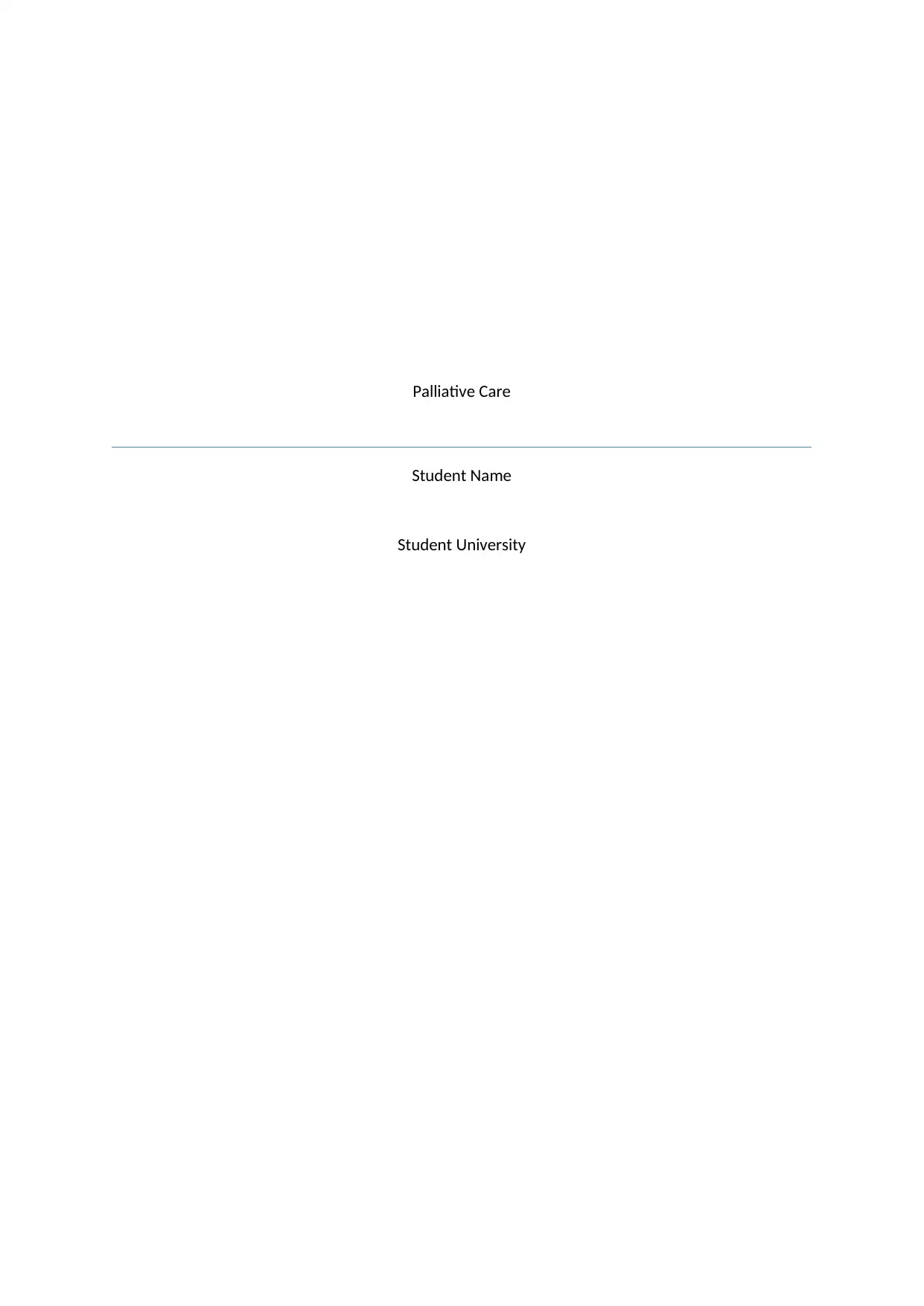
Palliative Care
Student Name
Student University
Student Name
Student University
Paraphrase This Document
Need a fresh take? Get an instant paraphrase of this document with our AI Paraphraser
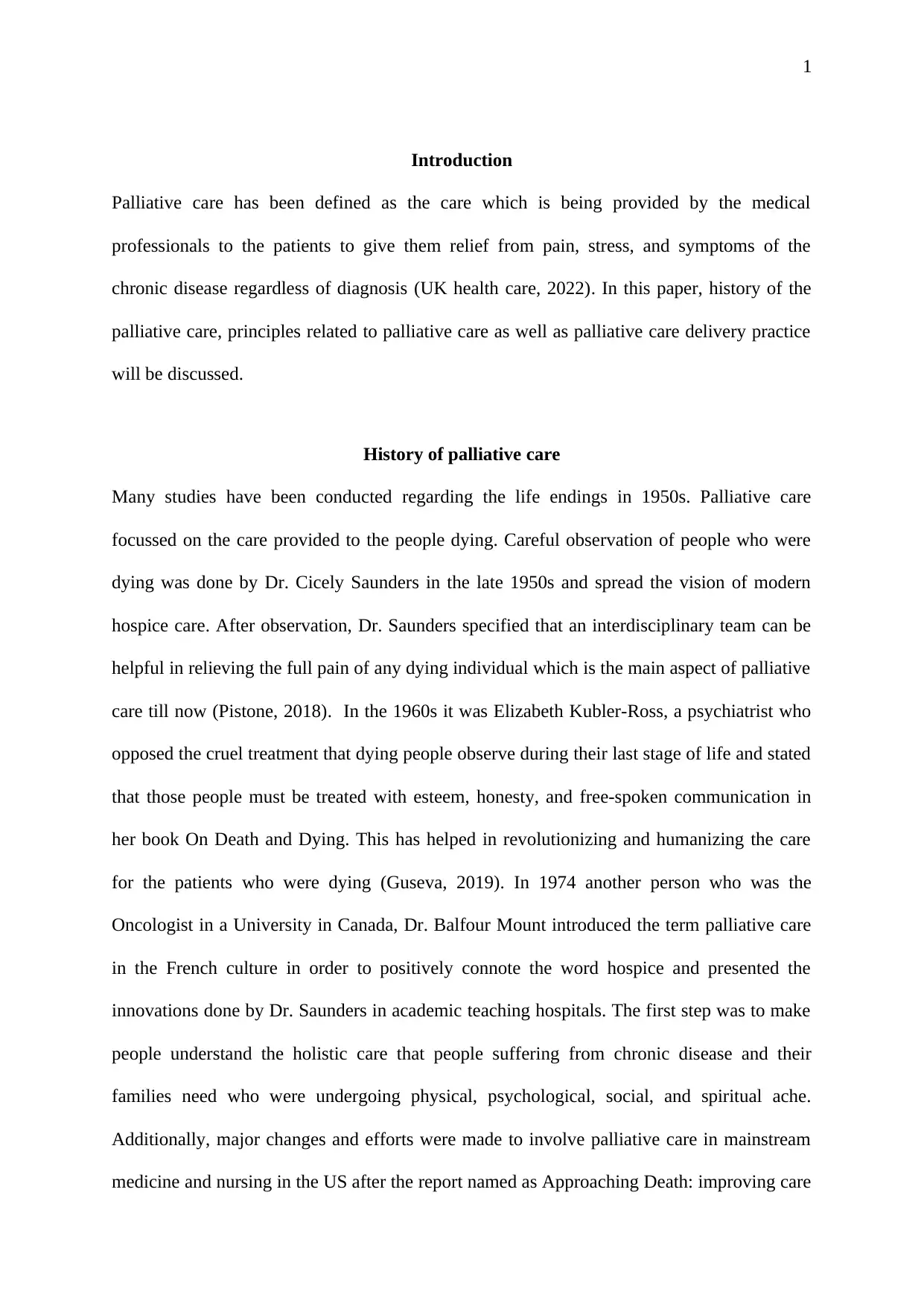
1
Introduction
Palliative care has been defined as the care which is being provided by the medical
professionals to the patients to give them relief from pain, stress, and symptoms of the
chronic disease regardless of diagnosis (UK health care, 2022). In this paper, history of the
palliative care, principles related to palliative care as well as palliative care delivery practice
will be discussed.
History of palliative care
Many studies have been conducted regarding the life endings in 1950s. Palliative care
focussed on the care provided to the people dying. Careful observation of people who were
dying was done by Dr. Cicely Saunders in the late 1950s and spread the vision of modern
hospice care. After observation, Dr. Saunders specified that an interdisciplinary team can be
helpful in relieving the full pain of any dying individual which is the main aspect of palliative
care till now (Pistone, 2018). In the 1960s it was Elizabeth Kubler-Ross, a psychiatrist who
opposed the cruel treatment that dying people observe during their last stage of life and stated
that those people must be treated with esteem, honesty, and free-spoken communication in
her book On Death and Dying. This has helped in revolutionizing and humanizing the care
for the patients who were dying (Guseva, 2019). In 1974 another person who was the
Oncologist in a University in Canada, Dr. Balfour Mount introduced the term palliative care
in the French culture in order to positively connote the word hospice and presented the
innovations done by Dr. Saunders in academic teaching hospitals. The first step was to make
people understand the holistic care that people suffering from chronic disease and their
families need who were undergoing physical, psychological, social, and spiritual ache.
Additionally, major changes and efforts were made to involve palliative care in mainstream
medicine and nursing in the US after the report named as Approaching Death: improving care
Introduction
Palliative care has been defined as the care which is being provided by the medical
professionals to the patients to give them relief from pain, stress, and symptoms of the
chronic disease regardless of diagnosis (UK health care, 2022). In this paper, history of the
palliative care, principles related to palliative care as well as palliative care delivery practice
will be discussed.
History of palliative care
Many studies have been conducted regarding the life endings in 1950s. Palliative care
focussed on the care provided to the people dying. Careful observation of people who were
dying was done by Dr. Cicely Saunders in the late 1950s and spread the vision of modern
hospice care. After observation, Dr. Saunders specified that an interdisciplinary team can be
helpful in relieving the full pain of any dying individual which is the main aspect of palliative
care till now (Pistone, 2018). In the 1960s it was Elizabeth Kubler-Ross, a psychiatrist who
opposed the cruel treatment that dying people observe during their last stage of life and stated
that those people must be treated with esteem, honesty, and free-spoken communication in
her book On Death and Dying. This has helped in revolutionizing and humanizing the care
for the patients who were dying (Guseva, 2019). In 1974 another person who was the
Oncologist in a University in Canada, Dr. Balfour Mount introduced the term palliative care
in the French culture in order to positively connote the word hospice and presented the
innovations done by Dr. Saunders in academic teaching hospitals. The first step was to make
people understand the holistic care that people suffering from chronic disease and their
families need who were undergoing physical, psychological, social, and spiritual ache.
Additionally, major changes and efforts were made to involve palliative care in mainstream
medicine and nursing in the US after the report named as Approaching Death: improving care
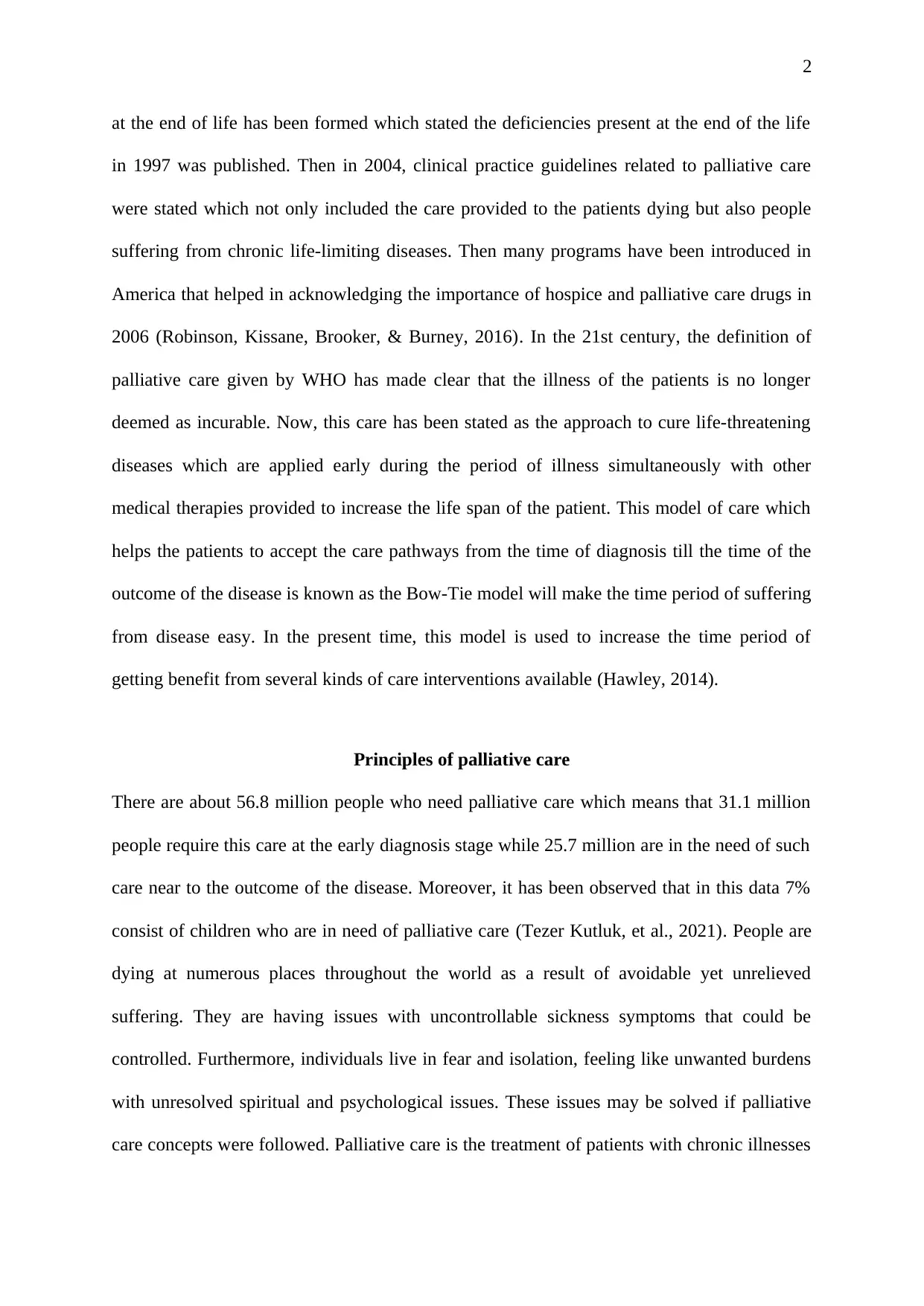
2
at the end of life has been formed which stated the deficiencies present at the end of the life
in 1997 was published. Then in 2004, clinical practice guidelines related to palliative care
were stated which not only included the care provided to the patients dying but also people
suffering from chronic life-limiting diseases. Then many programs have been introduced in
America that helped in acknowledging the importance of hospice and palliative care drugs in
2006 (Robinson, Kissane, Brooker, & Burney, 2016). In the 21st century, the definition of
palliative care given by WHO has made clear that the illness of the patients is no longer
deemed as incurable. Now, this care has been stated as the approach to cure life-threatening
diseases which are applied early during the period of illness simultaneously with other
medical therapies provided to increase the life span of the patient. This model of care which
helps the patients to accept the care pathways from the time of diagnosis till the time of the
outcome of the disease is known as the Bow-Tie model will make the time period of suffering
from disease easy. In the present time, this model is used to increase the time period of
getting benefit from several kinds of care interventions available (Hawley, 2014).
Principles of palliative care
There are about 56.8 million people who need palliative care which means that 31.1 million
people require this care at the early diagnosis stage while 25.7 million are in the need of such
care near to the outcome of the disease. Moreover, it has been observed that in this data 7%
consist of children who are in need of palliative care (Tezer Kutluk, et al., 2021). People are
dying at numerous places throughout the world as a result of avoidable yet unrelieved
suffering. They are having issues with uncontrollable sickness symptoms that could be
controlled. Furthermore, individuals live in fear and isolation, feeling like unwanted burdens
with unresolved spiritual and psychological issues. These issues may be solved if palliative
care concepts were followed. Palliative care is the treatment of patients with chronic illnesses
at the end of life has been formed which stated the deficiencies present at the end of the life
in 1997 was published. Then in 2004, clinical practice guidelines related to palliative care
were stated which not only included the care provided to the patients dying but also people
suffering from chronic life-limiting diseases. Then many programs have been introduced in
America that helped in acknowledging the importance of hospice and palliative care drugs in
2006 (Robinson, Kissane, Brooker, & Burney, 2016). In the 21st century, the definition of
palliative care given by WHO has made clear that the illness of the patients is no longer
deemed as incurable. Now, this care has been stated as the approach to cure life-threatening
diseases which are applied early during the period of illness simultaneously with other
medical therapies provided to increase the life span of the patient. This model of care which
helps the patients to accept the care pathways from the time of diagnosis till the time of the
outcome of the disease is known as the Bow-Tie model will make the time period of suffering
from disease easy. In the present time, this model is used to increase the time period of
getting benefit from several kinds of care interventions available (Hawley, 2014).
Principles of palliative care
There are about 56.8 million people who need palliative care which means that 31.1 million
people require this care at the early diagnosis stage while 25.7 million are in the need of such
care near to the outcome of the disease. Moreover, it has been observed that in this data 7%
consist of children who are in need of palliative care (Tezer Kutluk, et al., 2021). People are
dying at numerous places throughout the world as a result of avoidable yet unrelieved
suffering. They are having issues with uncontrollable sickness symptoms that could be
controlled. Furthermore, individuals live in fear and isolation, feeling like unwanted burdens
with unresolved spiritual and psychological issues. These issues may be solved if palliative
care concepts were followed. Palliative care is the treatment of patients with chronic illnesses
⊘ This is a preview!⊘
Do you want full access?
Subscribe today to unlock all pages.

Trusted by 1+ million students worldwide
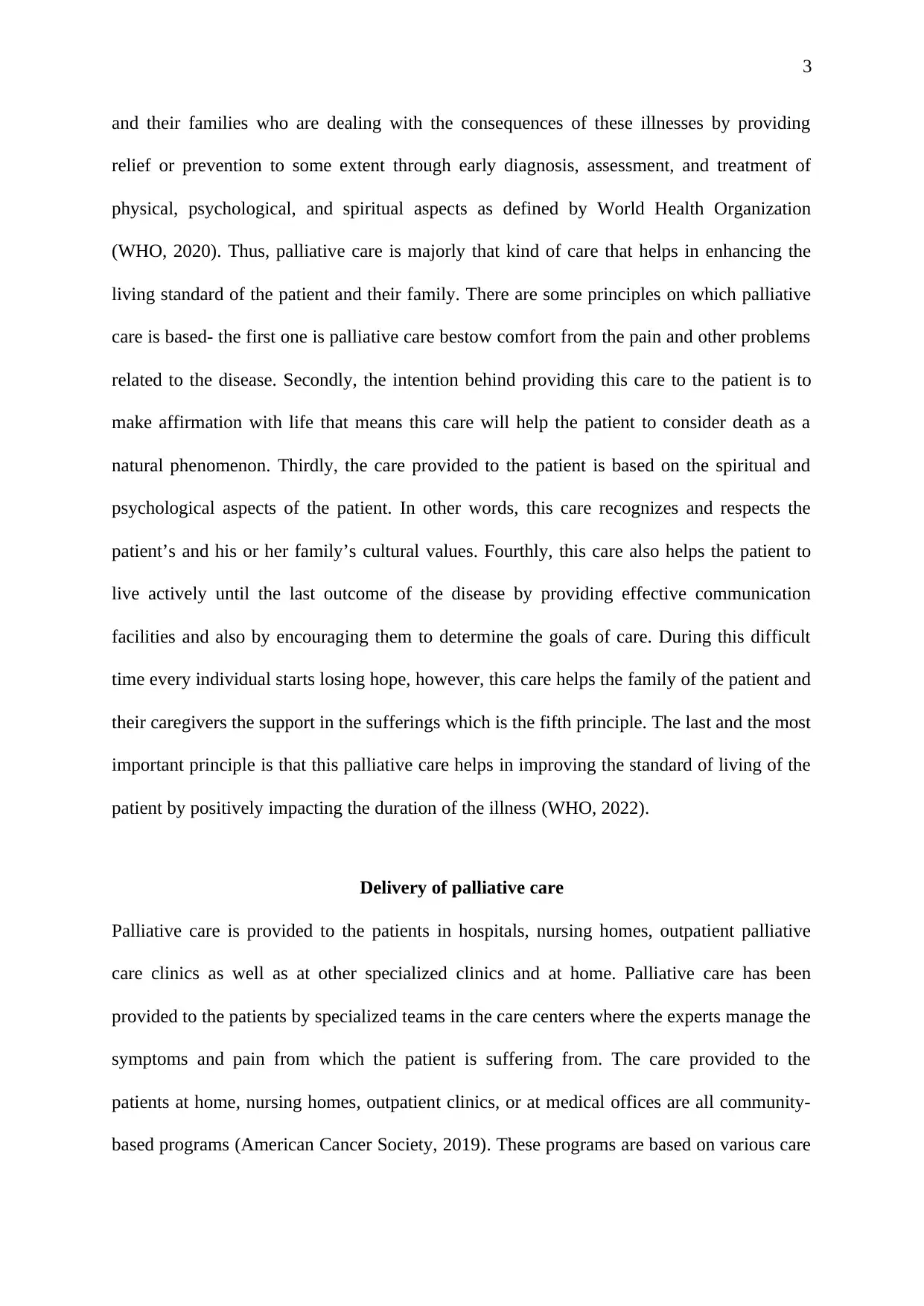
3
and their families who are dealing with the consequences of these illnesses by providing
relief or prevention to some extent through early diagnosis, assessment, and treatment of
physical, psychological, and spiritual aspects as defined by World Health Organization
(WHO, 2020). Thus, palliative care is majorly that kind of care that helps in enhancing the
living standard of the patient and their family. There are some principles on which palliative
care is based- the first one is palliative care bestow comfort from the pain and other problems
related to the disease. Secondly, the intention behind providing this care to the patient is to
make affirmation with life that means this care will help the patient to consider death as a
natural phenomenon. Thirdly, the care provided to the patient is based on the spiritual and
psychological aspects of the patient. In other words, this care recognizes and respects the
patient’s and his or her family’s cultural values. Fourthly, this care also helps the patient to
live actively until the last outcome of the disease by providing effective communication
facilities and also by encouraging them to determine the goals of care. During this difficult
time every individual starts losing hope, however, this care helps the family of the patient and
their caregivers the support in the sufferings which is the fifth principle. The last and the most
important principle is that this palliative care helps in improving the standard of living of the
patient by positively impacting the duration of the illness (WHO, 2022).
Delivery of palliative care
Palliative care is provided to the patients in hospitals, nursing homes, outpatient palliative
care clinics as well as at other specialized clinics and at home. Palliative care has been
provided to the patients by specialized teams in the care centers where the experts manage the
symptoms and pain from which the patient is suffering from. The care provided to the
patients at home, nursing homes, outpatient clinics, or at medical offices are all community-
based programs (American Cancer Society, 2019). These programs are based on various care
and their families who are dealing with the consequences of these illnesses by providing
relief or prevention to some extent through early diagnosis, assessment, and treatment of
physical, psychological, and spiritual aspects as defined by World Health Organization
(WHO, 2020). Thus, palliative care is majorly that kind of care that helps in enhancing the
living standard of the patient and their family. There are some principles on which palliative
care is based- the first one is palliative care bestow comfort from the pain and other problems
related to the disease. Secondly, the intention behind providing this care to the patient is to
make affirmation with life that means this care will help the patient to consider death as a
natural phenomenon. Thirdly, the care provided to the patient is based on the spiritual and
psychological aspects of the patient. In other words, this care recognizes and respects the
patient’s and his or her family’s cultural values. Fourthly, this care also helps the patient to
live actively until the last outcome of the disease by providing effective communication
facilities and also by encouraging them to determine the goals of care. During this difficult
time every individual starts losing hope, however, this care helps the family of the patient and
their caregivers the support in the sufferings which is the fifth principle. The last and the most
important principle is that this palliative care helps in improving the standard of living of the
patient by positively impacting the duration of the illness (WHO, 2022).
Delivery of palliative care
Palliative care is provided to the patients in hospitals, nursing homes, outpatient palliative
care clinics as well as at other specialized clinics and at home. Palliative care has been
provided to the patients by specialized teams in the care centers where the experts manage the
symptoms and pain from which the patient is suffering from. The care provided to the
patients at home, nursing homes, outpatient clinics, or at medical offices are all community-
based programs (American Cancer Society, 2019). These programs are based on various care
Paraphrase This Document
Need a fresh take? Get an instant paraphrase of this document with our AI Paraphraser
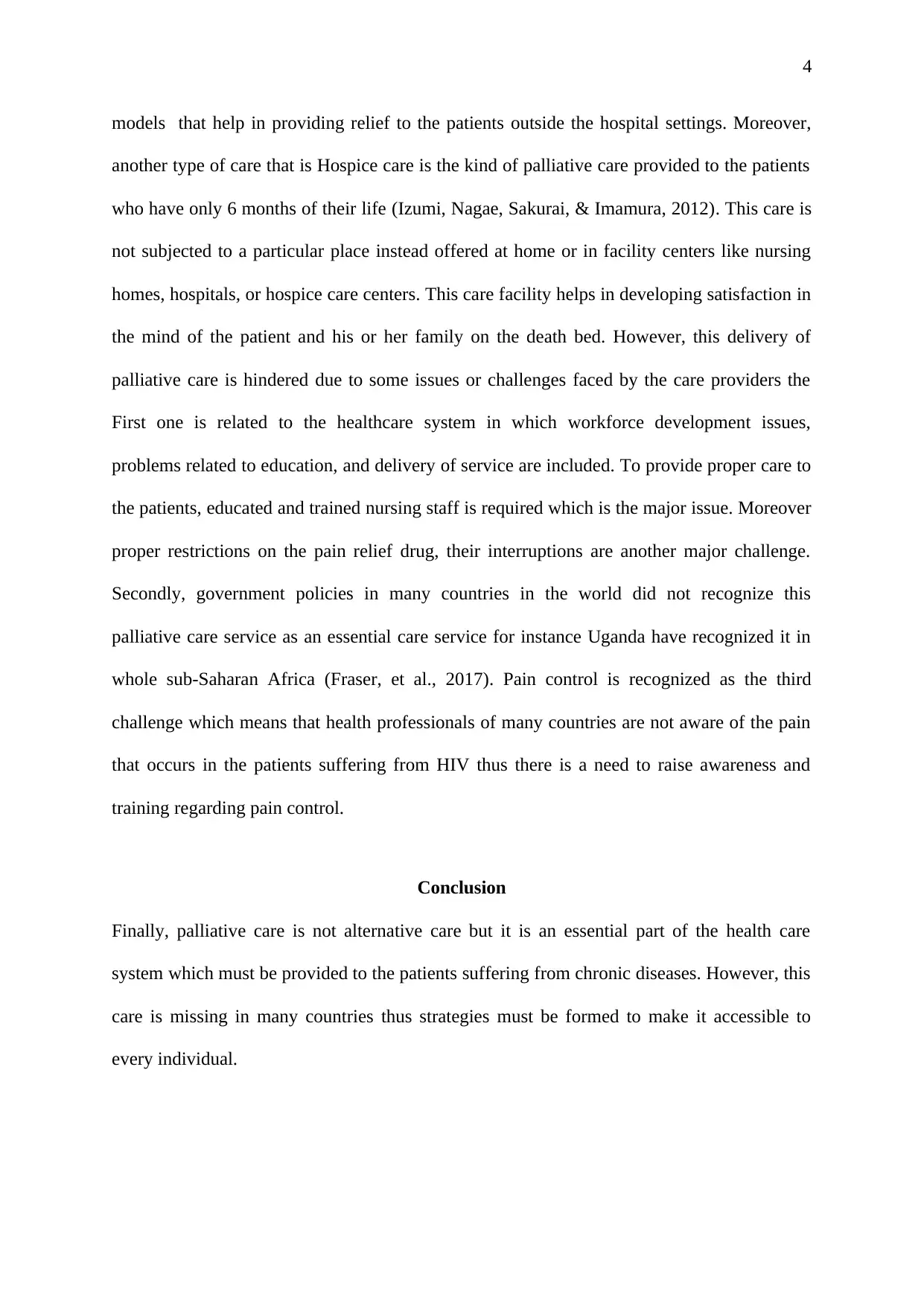
4
models that help in providing relief to the patients outside the hospital settings. Moreover,
another type of care that is Hospice care is the kind of palliative care provided to the patients
who have only 6 months of their life (Izumi, Nagae, Sakurai, & Imamura, 2012). This care is
not subjected to a particular place instead offered at home or in facility centers like nursing
homes, hospitals, or hospice care centers. This care facility helps in developing satisfaction in
the mind of the patient and his or her family on the death bed. However, this delivery of
palliative care is hindered due to some issues or challenges faced by the care providers the
First one is related to the healthcare system in which workforce development issues,
problems related to education, and delivery of service are included. To provide proper care to
the patients, educated and trained nursing staff is required which is the major issue. Moreover
proper restrictions on the pain relief drug, their interruptions are another major challenge.
Secondly, government policies in many countries in the world did not recognize this
palliative care service as an essential care service for instance Uganda have recognized it in
whole sub-Saharan Africa (Fraser, et al., 2017). Pain control is recognized as the third
challenge which means that health professionals of many countries are not aware of the pain
that occurs in the patients suffering from HIV thus there is a need to raise awareness and
training regarding pain control.
Conclusion
Finally, palliative care is not alternative care but it is an essential part of the health care
system which must be provided to the patients suffering from chronic diseases. However, this
care is missing in many countries thus strategies must be formed to make it accessible to
every individual.
models that help in providing relief to the patients outside the hospital settings. Moreover,
another type of care that is Hospice care is the kind of palliative care provided to the patients
who have only 6 months of their life (Izumi, Nagae, Sakurai, & Imamura, 2012). This care is
not subjected to a particular place instead offered at home or in facility centers like nursing
homes, hospitals, or hospice care centers. This care facility helps in developing satisfaction in
the mind of the patient and his or her family on the death bed. However, this delivery of
palliative care is hindered due to some issues or challenges faced by the care providers the
First one is related to the healthcare system in which workforce development issues,
problems related to education, and delivery of service are included. To provide proper care to
the patients, educated and trained nursing staff is required which is the major issue. Moreover
proper restrictions on the pain relief drug, their interruptions are another major challenge.
Secondly, government policies in many countries in the world did not recognize this
palliative care service as an essential care service for instance Uganda have recognized it in
whole sub-Saharan Africa (Fraser, et al., 2017). Pain control is recognized as the third
challenge which means that health professionals of many countries are not aware of the pain
that occurs in the patients suffering from HIV thus there is a need to raise awareness and
training regarding pain control.
Conclusion
Finally, palliative care is not alternative care but it is an essential part of the health care
system which must be provided to the patients suffering from chronic diseases. However, this
care is missing in many countries thus strategies must be formed to make it accessible to
every individual.
1 out of 5
Related Documents
Your All-in-One AI-Powered Toolkit for Academic Success.
+13062052269
info@desklib.com
Available 24*7 on WhatsApp / Email
![[object Object]](/_next/static/media/star-bottom.7253800d.svg)
Unlock your academic potential
Copyright © 2020–2025 A2Z Services. All Rights Reserved. Developed and managed by ZUCOL.





